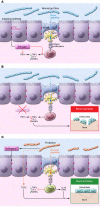From the gut to the strut: where inflammation reigns, bone abstains
- PMID: 27111233
- PMCID: PMC4887160
- DOI: 10.1172/JCI87430
From the gut to the strut: where inflammation reigns, bone abstains
Abstract
In this issue of the JCI, Li et al. show that germ-free mice, when chemically castrated, do not lose bone - a finding that unequivocally establishes a role of gut microbiota in mediating hypogonadal bone loss. Additionally and not unexpectedly, probiotics reversed hypogonadal osteopenia in sex steroid-deficient mice by preventing the disruption of gut barrier function and dampening cytokine-induced inflammation. The authors propose that TNFα is a key mediator; however, it is very likely that other molecules - including IL-1, IL-6, IL-17, RANKL, OPG, and CCL2 - modulate probiotic action. The results of this study highlight the potential for repurposing probiotics for the therapy of osteoporosis. Future placebo-controlled clinical trials will be required to establish safety and efficacy of probiotics in reducing fracture risk in people.
Figures

Comment on
-
Sex steroid deficiency-associated bone loss is microbiota dependent and prevented by probiotics.J Clin Invest. 2016 Jun 1;126(6):2049-63. doi: 10.1172/JCI86062. Epub 2016 Apr 25. J Clin Invest. 2016. PMID: 27111232 Free PMC article.
References
Publication types
MeSH terms
Substances
Grants and funding
LinkOut - more resources
Full Text Sources
Other Literature Sources

